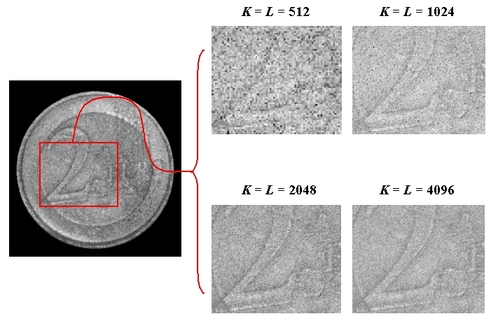
The effect of zero-padding
It was mentioned in the course material that it is possible to carry out a ‘zero-padding' and what the consequences of this are. This aspect is represented in figure 26 which shows the area round the “2” on the coin as it appears for reconstruction with a varying number of points (512,1024,2048,4096).

When
 , the hologram is truncated since the number of points which have been retained is a lot lower than the initial matrix (1024x1360). In this case, the resolution is reduced because
, the hologram is truncated since the number of points which have been retained is a lot lower than the initial matrix (1024x1360). In this case, the resolution is reduced because
 ; the reconstructed image appears badly formed. When
; the reconstructed image appears badly formed. When
 , the number of points that have been retained is roughly equal to that provided by the sensor (1024 against 1360 horizontally); the image sampling corresponds to the intrinsic resolution given by the pixel matrix, which is
, the number of points that have been retained is roughly equal to that provided by the sensor (1024 against 1360 horizontally); the image sampling corresponds to the intrinsic resolution given by the pixel matrix, which is
 ; therefore the image appears to be “pixelised”.
; therefore the image appears to be “pixelised”.
For
 , zero-padding is effective and the sampling of the image plane is half the resolution; the resolution function
, zero-padding is effective and the sampling of the image plane is half the resolution; the resolution function
 is therefore sampled with the better definition which allow for the fine texture of the image and in particular its speckle granularity to be brought into perspective. For
is therefore sampled with the better definition which allow for the fine texture of the image and in particular its speckle granularity to be brought into perspective. For
 , the sampling of the image plane is now four times smaller than the resolution. We get
, the sampling of the image plane is now four times smaller than the resolution. We get
 and
and
 and the sampling pitch is
and the sampling pitch is
 . The definition of the image plane is even better but the speckle granularity doesn't necessarily change with size; it is imposed by the resolution of the method and therefore by the size of the CCD sensor.
. The definition of the image plane is even better but the speckle granularity doesn't necessarily change with size; it is imposed by the resolution of the method and therefore by the size of the CCD sensor.